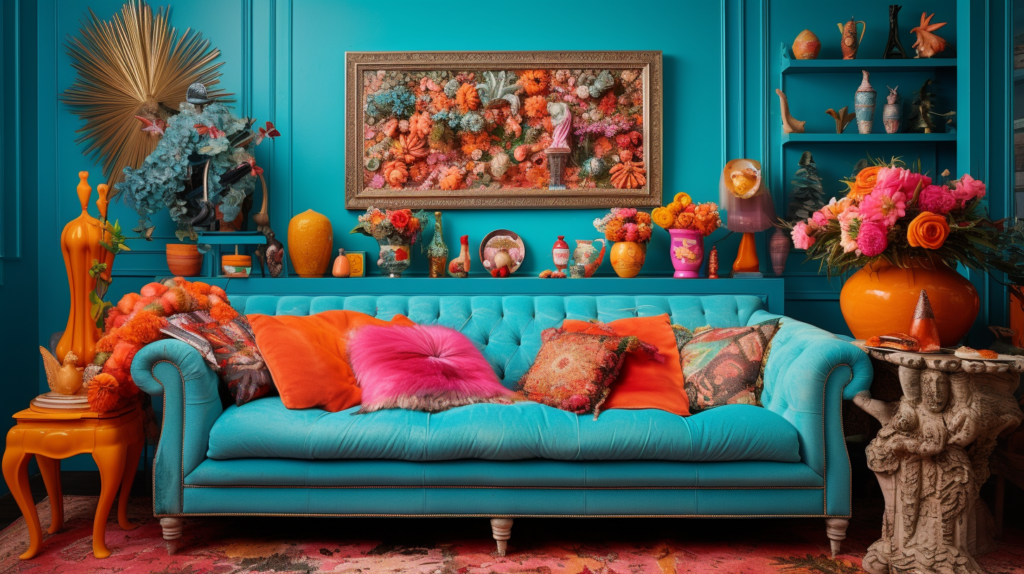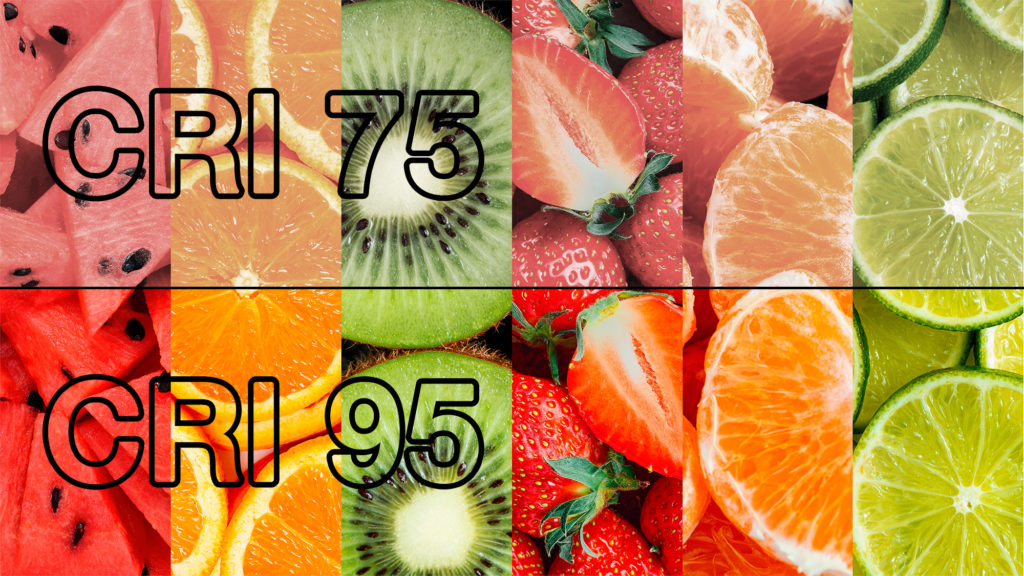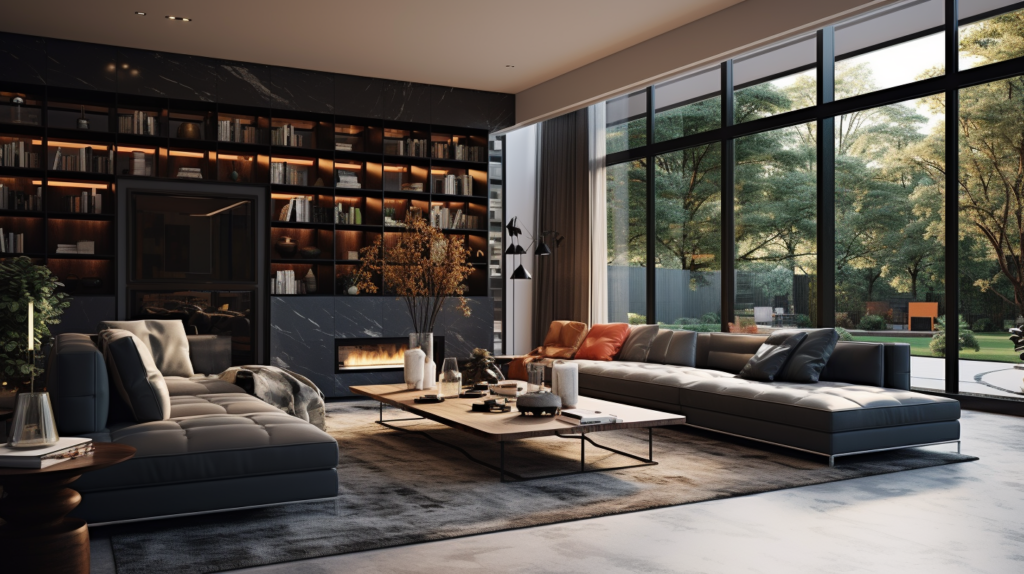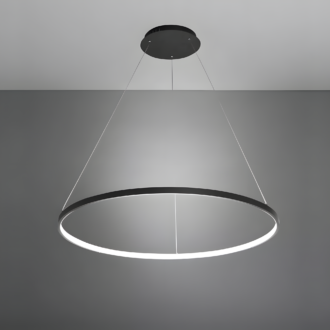What Is Color Rendering Index (CRI)? August 11, 2016 – Posted in: Lighting Information, General Info

Table of Contents
Ever had that moment when the same outfit seems to morph colors under different lighting conditions? We can all relate, right? Especially when we’ve carefully picked out a dress that appeared blue in our bedroom’s light but it turns into green once inside the boutique.
Or, that time you cooked steak to what seemed like the perfect shade of pink at your glowing kitchen counter yet found it raw and uncooked after slicing into it. This surprising effect has a scientific explanation: Color Rendering Index.
In this article, we’re going to lift the veil on CRI – explaining what exactly it is, how it plays magic tricks with our color perception, and its essential role while picking out your lighting options.
So buckle up for an illuminating journey deep dive into light and color!
Key Points
- CRI is an index that tells how true colors look under a light source. High values show colors best, close to natural sunlight.
- We measure CRI by comparing colors using a test and reference lights. The scores come from how much color changes between sunlight and your light.
- The right CRI light makes your home, office or store looks its best. Lights with high score are also good for art studios and places where color matters a lot.
- There are limits with using only CRI for judging light quality. So, we can use other ways like TM-30-15 which tests many more colors for better results.
Understanding Color Rendering Index (CRI) In LED Lighting
In this section, we’ll dive deep into the concept of Colour Rendering Index, exploring its definition and importance. We’ll shed light on how CRI influences our perception of color and why it plays a pivotal role in choosing the right lighting for various applications.
Definition of CRI

Color Rendering Index shows how true the colors look under a light source. For example, think of sunlight. We use it as our guide or base point and say its CRI of 100. A perfect score.
That’s because colors look very real in sunlight. Now, let’s talk about artificial lights like bulbs and LED lights. The CRI tells us how close these lights can show the true colors of objects when compared to sunlight or natural light.
The higher the CRI value, the better we see colors. So if a bulb has a rich CRI of 90, it means that it can show color almost as well as daylight!
Importance of CRI in lighting design

CRI in lighting is key to see true colors. A light source with a great CRI rating makes all colors look bold and lively, just like they do under natural sunlight.
In places where color matters a lot, like art studios or fabric stores, lights with high CRI are used so that people can see accurate colors. But it’s not just for those places! In our homes too, using lights with high CRI lets us enjoy bright and rich colors of everything around us – our food, clothes, furniture – making them look their best.
Therefore picking light fixtures based on their CRI rating is very useful when thinking about creating great lighting options in different settings. Using LED light or any other type of light with a higher CRI gives the most pleasing and real color appearance possible.
How CRI affects color perception

CRI plays a big role in how we see color. If a light source has high CRI, it shows the colors of objects more truly and naturally. For example, under a bulb with high CRI, red apples look bright and fresh.
But under low CRI lighting, the same apples might look dark or dull. It’s also key to know that better color accuracy comes from higher scores on the CRI scale.
Light sources with a score over 80 are seen as having good color rendering abilities. But those with lower scores can distort or wash out colors badly.
Measuring Color Rendering Index (CRI)

When it comes to measuring CRI, a variety of testing methods are used. These procedures generally involve comparing the appearance of color samples under a test light source to their appearance under a reference light source, usually natural daylight or incandescent lighting.
The common CRI values range from 0 (poor) to 100 (excellent), providing users with an excellent gauge of lighting quality. In considering non-daylight color temperatures, different factors come into play that could influence the CRI value and thus user perception.
Test method for determining CRI

We use a special way to find the color rendering index, also known as CRI. Here’s how we do it:
- First, we pick a light source that we want to test. This light can be any type, from an LED strip light to a fluorescent bulb.
- Next, we put this light in a lighting laboratory. It is here that the main work gets done.
- We then use eight color samples under the test light and under a reference light source. The reference can be natural light or incandescent light, depending on the correlated color temperature.
- After that, we look at how each of the color samples changes when we shine the two types of lights on them.
- Then we score each sample out of 100 based on how much the colors shift between the two lights.
- Lastly, we add up all these scores and divide by eight – giving us our final CRI number for our test light.
CRI can also be measured in a very simple, yet not so accurate way, at home too:
- Take a color chart outside into direct sunlight.
- Set you camera into daylight mode – this will be your reference point.
- Use a gray card to set exposure (50 IRE), and take a photo of the color chart.
- Repeat the process with your light source.
- Compare color differences to see how vast they are. You could get 80, 90, and 98 measured CRI bulbs to have further reference points at different CRI levels.
Just remember that no light source has perfect CRI, unless you managed to fit a piece of sun into your fixture.
Common CRI values and their significance

When it comes to lighting, you’ll find that there’s a wide range of Color Rendering Index (CRI) scores. These scores can have a significant impact on how we perceive the colors of objects. Now, let’s take a look at some common CRI values and their significance.
| CRI Value | Color Accuracy | Example Applications |
|---|---|---|
| 90-100 | Excellent | Art galleries, photography studios, design workspaces where color accuracy is crucial. |
| 80-89 | Good | Residential and commercial spaces like homes and offices where good color perception is important but not critical. |
| 70-79 | Fair | Areas where color accuracy is less important such as outdoor lighting, warehouses, and industrial spaces. |
| Below 70 | Poor | Lighting that requires little to no color accuracy, such as security lighting or pathway lighting. |
It’s important to choose a light source with a CRI value suited to the space’s intended use. High CRI values offer the most accurate color reproduction, mimicking the effects of natural sunlight as closely as possible.
Considerations for non-daylight color temperatures

We need to think about a few things for lights that don’t copy daylight. On top of this, we must keep in mind that CRI and color temperature are not the same thing.
We measure color temperature with Kelvin (K). So even though a light might have a high CRI, it could still have warm or cool tones based on its color temperature.
A change in tone can impact how we see and feel about colors around us!
Applications and Considerations of CRI

Ever wondered how the CRI affects different environments or how to pick out lighting fixtures based on their CRI? In our next section, we’ll delve into these details and also address some of the limitations of using CRI as a sole gauge for light quality.
Keep reading, you won’t want to miss this!
Impact of CRI on different settings (e.g., residential, commercial)

In homes, high CRI lighting can make colors pop. Walls and furniture look brighter. In stores, good color rendering makes goods appear vibrant. It can help show the real color of clothes or food.
Higher CRI in office spaces helps to reduce eye strain. Workers feel more alert and less tired during the day. High-CRI LED lighting in art galleries shows true colors of paintings and sculptures too.
Choosing lighting fixtures based on CRI

There’s a few things to keep in mind when choosing lighting based on the color rendering index:
- Look for CRI of 80 or higher for indoor residential lighting
- High CRI bulbs like halogen and LED tend to be more expensive but provide truer, vivid colors.
- Test different CRI bulbs at home by shining them on colored objects to see which one makes the colors look more vibrant.
- Outdoor lighting usually doesn’t require a high CRI rating, reserve that for primarily task areas.
Limitations of CRI and alternative measures (e.g., TM-30-15)

CRI is not perfect. It does not judge reds, whites, and violets well. It also gives low scores to lights we find pleasing to the eye. This problem comes from CRI’s focus on a few color samples only.
It misses the real ability of a light source to show colors.
There are better alternatives to test the color spectrum but I wouldn’t waste time on it unless color accuracy is critical for your field.
The best one might be TM-30-15. This method uses 99 colors for testing instead of just eight with CRI. TM-30-15 has three parts: Fidelity Index, Gamut index, and Color Vector Graphic which all work together for a truer test result.
Frequently Asked Questions
What is the Color Rendering Index (CRI)?
The Color Rendering Index, or CRI, is a scale from 0 to 100. It shows how well a light source reveals the true color of an object.
How does CRI work?
Light sources with a high CRI show colors more truly than those on the lower end. The highest CRI is 100, like natural light. A bulb with a general CRI of around 80 to 90 gives good color quality.
Why do lighting designers use the Color Rendering Index?
Designers use the Color Rendering Index to make sure lights give off accurate colors. They want people to see things as they would in natural light.
Can different types of light sources have different CRIs?
Yes! Types like incandescent and halogen lights can have a top score of up to 100 on this index, while some fluorescent ones may get lower scores like around 75-80 only.
What role does this play in buying light bulbs by customers or manufacturers making them?
Understanding ‘CRI’ measurement helps buyers choose better lighting products based on color qualities they produce; it also aids manufacturers in creating improved illumination devices that offer brilliant and consistent visibility across different settings.
I have been the project manager for Modern.Place since early 2016, spending three of those years working overseas on the manufacturing & procurement side of the LED lighting industry. Constantly learning and passing on knowledge to others while excited for what the lighting industry will involve into next.





